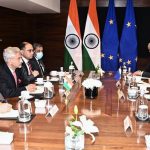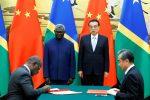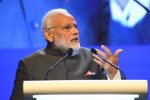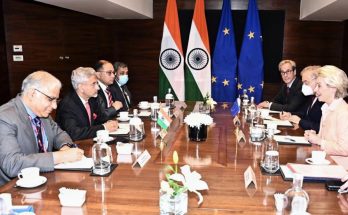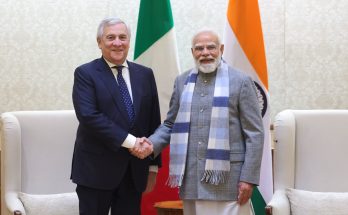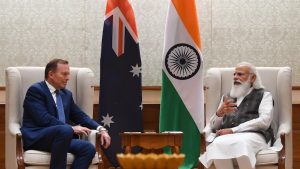
Australian Prime Minister Scott Morrison’s special trade envoy, former prime minister Tony Abbot, was in India from August 2-6. The primary aim was to revitalize the discussions of the bilateral Comprehensive Economic Cooperation Agreement (CECA) talks which have been stalled since 2015 after nine rounds, ostensibly due to the RCEP negotiations. During his action-packed visit Mr Abbot called upon PM Modi, held extensive discussions with Commerce, Industry and Textiles Minister Piyush Goyal, Finance Minister Nirmala Sitharaman, Information & Broadcasting, Youth Affairs & Sports Minister Anurag Thakur, Minister of Coal, Mines and Parliamentary Affairs Prahalad Joshi and Niti Ayog CEO Amitabh Kant. He also met businessman Gautam Adani, who has mining interests in Australia, a host of parliamentarians and a cross-section of individuals from government, business and Chambers of Commerce.
Changing Equations
Tony Abbot would have noted a sea change in the attitude of his interlocutors since his previous visit to India in 2019. The geo- political scenario has changed drastically since then. The Indo-Pacific has seen an aggressive rise of China, the Quad has responded with its own initiatives to counter tendencies which threaten freedom of navigation, overflights and a free and open region so necessary for unimpeded trade, and a Supply Chains Resilience initiative has been announced by the trade ministers of Australia, India and Japan to counter threats to their economic wellbeing and prosperity. The Indo-Australian relationship itself has been elevated to a Comprehensive Strategic Partnership. Economic cooperation is now the key to further strengthening of ties between India and Australia.
An India Economic Strategy to 2035 report was launched by Australia in November 2018 and a reciprocal Australia Economic Strategy Report was released in 2020 by Indian Minister Piyush Goyal – both have clearly outlined a roadmap for the future areas of trade and investments. The Australian strategy concentrates on 10 sectors and 10 states in India, while the Indian strategy focuses on 10 core sectors and 10 futuristic sectors without ruling out any particular state in Australia. Both strategies lay emphasis on an investment led growth in trade and linkages which will endure for many years to come.
Transforming India
As India looks to transform itself into a nation based on resilient and inclusive economic growth, it will require to partner with countries who rely on innovation and high technology, and research and development, so that it can compete with others by manufacturing qualitatively better goods. India also requires essential minerals and commodities for its programmes which will move away from fossil fuels, usher in a revolution in clean technologies, including e – vehicles, and fulfill its infrastructure needs. Australia fits this bill perfectly.
The Modi government is aware that far reaching reforms and further improvement in the ease of doing business in India will help lift millions out of poverty, bring in much needed Foreign Direct Investment into India and place India on a higher pedestal in the comity of nations, as it prepares to host the G -20 leaders in the near future. Recent reforms in the mining, health care, IT, infrastructure, defense, space, agriculture, medium and small enterprises, financial and banking sectors have all attracted attention of investors around the world, as India attracted a record US$ 81.7 billion FDI in 2020-21.
India has successfully launched production-linked incentive schemes in 13 sectors. The aim is to make India a resilient manufacturing hub and to achieve a minimum production worth more than $500 billion in five years. In a landmark development over the past few days, India abolished retrospective taxation through a legislation, bringing about predictability and stability in the investment environment. Prime Minister Modi addressed a joint virtual gathering of Indian Ambassadors, his cabinet colleagues, top officials of the central and state governments, chamber of commerce and exporters, to impress upon them the need to give an added push to Indian exports and to create a new image of “brand India” which will help reduce dependencies on imports and also earn much needed revenue for the Indian economy.
India knows that further reforms are needed in the labour and land segments. It is trying to modernize its agriculture, food processing and grains storage technologies, as well as dairy yields and trying to make clean drinking water, electricity and digital connectivity available to all its villages. Mr. Abbot would have been apprised of these changes taking place in india, and the opportunities before Australian companies and investors across the board in all these sectors – in particular, in mining, and critical minerals.
The Indo-Australian collaboration in vaccines has become critical in the context of the Quad, and mutual needs can be fulfilled in the cyber security, IT and financial fields. Australian companies are aware of the potential for collaboration in grains management, waste control, cost rationalization and logistics. India’s infrastructure development of its airports, ports, inland waterways and toll roads has provided an opportunity for Australian investment funds to obtain good returns, while the education sector, especially skilling has been an Australian traditional strongpoint. If the two countries can do more in the newly-opened defense and space sectors, the partnership can obtain stronger foundations.
CECA: Next Steps
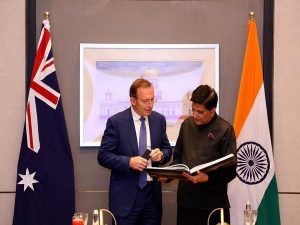
The Comprehensive Economic Cooperation Agreement (CECA) negotiations are back on track after a commitment by both Prime Ministers during their virtual meeting in 2020, and two rounds of official talks have also taken place. Meanwhile, bilateral trade has languished last year, possibly due to lockdowns due to the pandemic, but given that it has been above the $20 billion mark over the last few years, both sides need to move quickly to create better conditions for a revival. Although $15 billion apiece has been invested by India and Australia in each other’s economies, Mr. Abbot realizes that investment-led trade enhancement will be much more sustainable. His task is therefore not an easy one – the big businesses in Australia have been used to trading and dealing with China and have only just come to realise that they need to look at alternate markets. For this to happen, a sustained outreach is required, and India needs to begin to sound interesting to these larger Australian investors. As he moves forward on providing a push to the bilateral CECA, which will bring Australian and India exporters on a level playing field against competition, he will have to bear in mind that there are sensitives in India as far as reducton of tariffs across the board in the agriculture, dairy, fruits, wines and processed food segments.
However, niche items within these sectors are open to negotiations. An interim agreement on trade in goods covering some of the bilateral trade tariff lines which will benefit both sides while continuing to work towards a comprehensive agreement is becoming an attractive option. Services and investments will need much more work. If reciprocal tariff reductions can be negotiated in niche areas which are seen as low hanging fruit, India would like to see tariffs reduced in return on its exports of refined petroleum, medicaments, railway vehicles, gems and jewelry, auto components and made-up textile items.
India may not be averse to cutting down selected tariffs over specified periods for selected commodities, rare earths and minerals needed for its next generation production and programmes, and Australia could show some movement in selected services areas like financial and cyber security technologies, cloud computing and labor-intensive services for its remote areas which lack skilled personnel.

India has always sought to facilitate easy physical movement of its qualified nationals, a fair and easy visa regime for its services, as well as equally applicable, non-discriminatory banking regulations and taxation for its companies operating abroad. Australia could be assured predictability, consistency and simplification of procedures for its investments by providing a special window clearance just like Japan. limited FTAs like those in critical minerals and technologies, pharmaceuticals and chemicals could help. A CEOs Business Forum has not met for many months, both sides need to devise a consultation mechanism to remove barriers to trade and investment with government and business representatives, and intensify their outreach and consultations with the affected businessmen, investors and stakeholders.
The promise of startups, and innovation should not be forgotten, and they should be given governmental support in order to boost trade and manufacturing. If the two sides can start immediate discussions of rules of origin, dispute settlement mechanisms, barriers to trade, and trade facilitation while identifying areas of cooperation in services, this will also serve the purpose of easing their consultations with their common partner, Japan, for 2-or 3 selected areas where they could strengthen collaboration on establishing resilient supply chains. Prudence and patience are the key, and as Mr. Abbot heads back from India to take stock, while in a 14-day quarantine, he would try to unravel the complexity of the CECA negotiations with India.

(Ambassador Anil Wadhwa is a former Secretary (East) in the Indian Ministry of External Affairs, and has served as the Indian Ambassador to Poland, Oman, Thailand and Italy. Currently, he is a Distinguished Fellow with the Vivekananda International Foundation in New Delhi. He is the author of the Australia Economic Strategy, prepared for the Confederation of Indian Industries and released by the Indian Minister of Commerce, Industry & Textiles in November 2020. He is also Distinguished Advisor, India Writes Network & India and The World magazine)
- The views expressed in this column are solely those of the author
Author Profile

Latest entries
 India and the WorldJanuary 5, 2026India-EU Summit 2026: A Turning Point in Global Partnership
India and the WorldJanuary 5, 2026India-EU Summit 2026: A Turning Point in Global Partnership DiplomacyMay 23, 2022Indo-Pacific dynamics will drive Tokyo Quad Summit
DiplomacyMay 23, 2022Indo-Pacific dynamics will drive Tokyo Quad Summit India and the WorldAugust 13, 2021Tony Abbot’s Delhi Mission: Revitalizing India-Australia CECA & Economic Ties
India and the WorldAugust 13, 2021Tony Abbot’s Delhi Mission: Revitalizing India-Australia CECA & Economic Ties India and the WorldAugust 14, 2019Navigating Indo-Pacific: India’s Strategy
India and the WorldAugust 14, 2019Navigating Indo-Pacific: India’s Strategy

